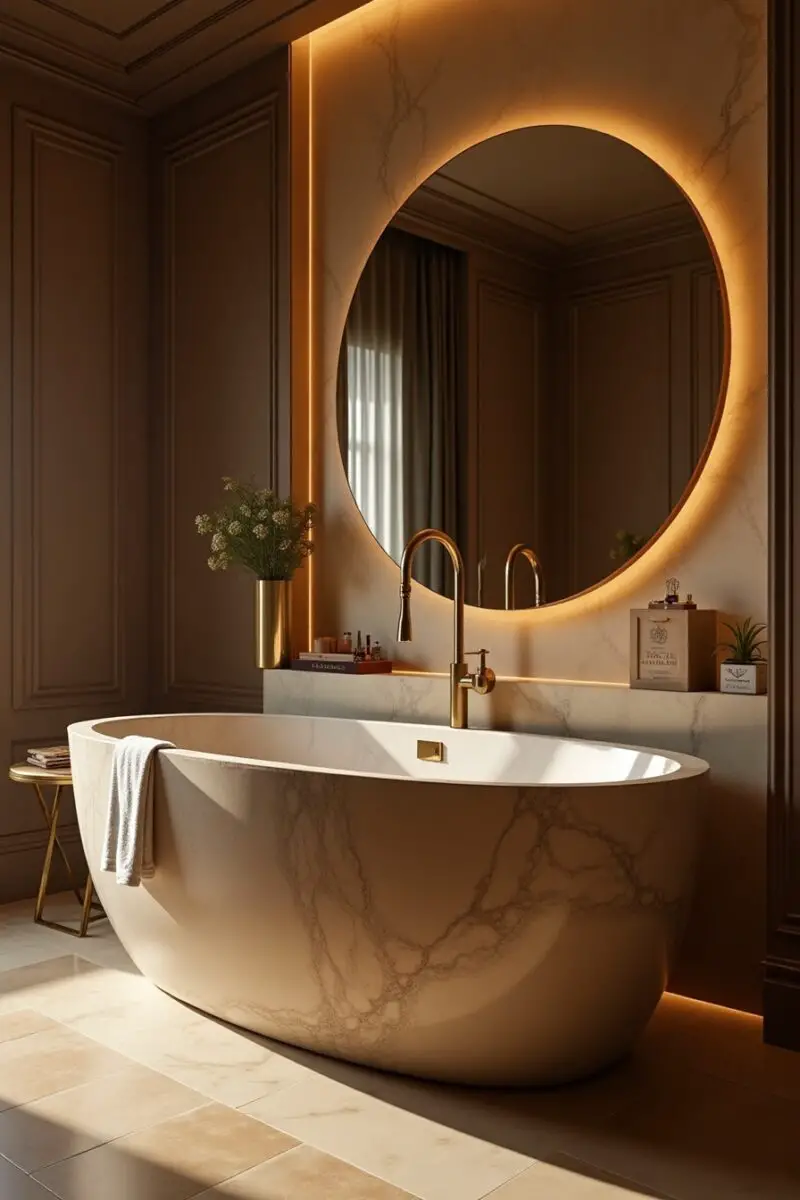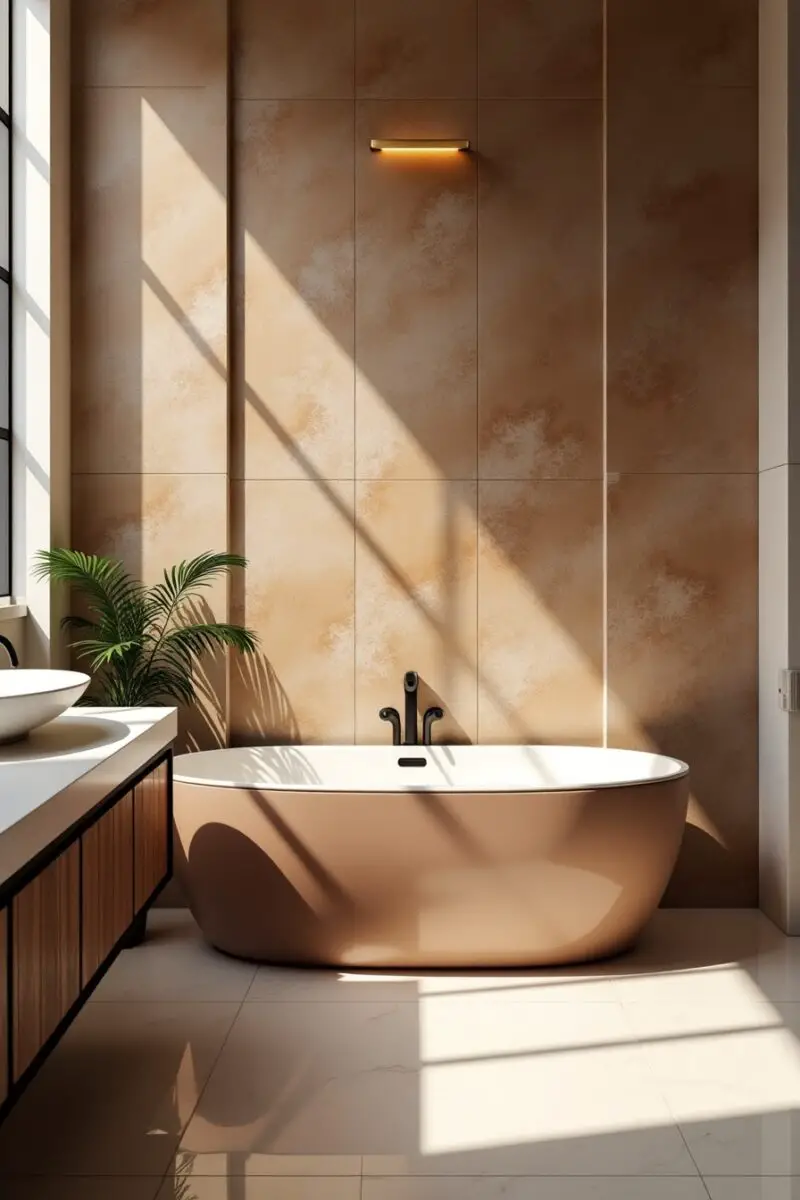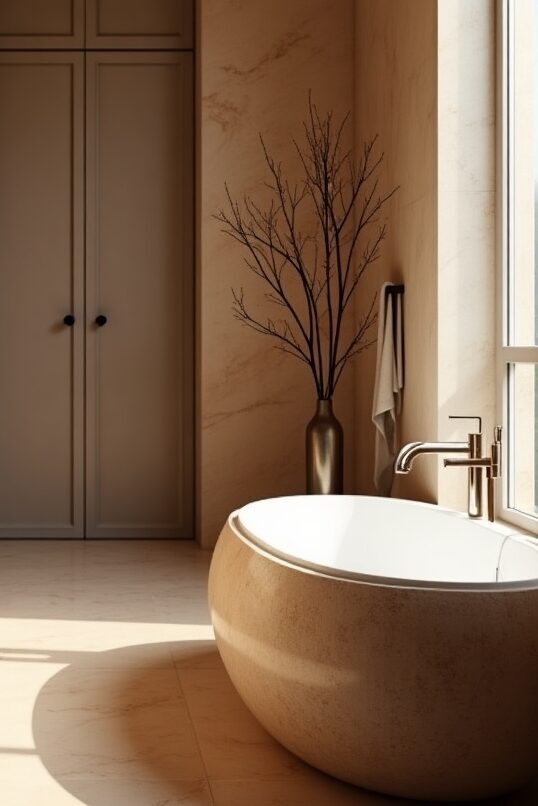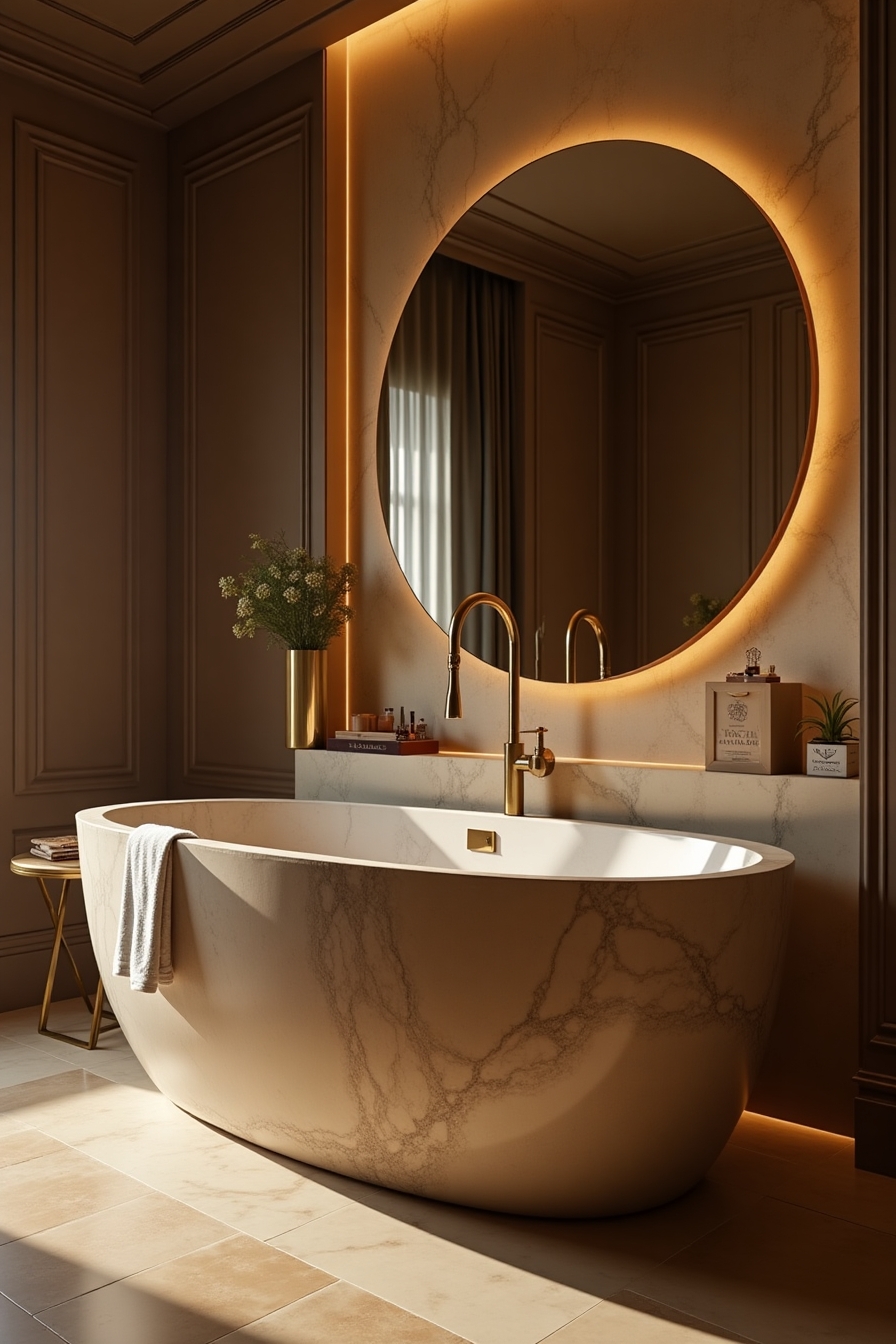Brown and beige bathrooms are making a tremendous comeback, but not in the dated way you might remember from decades past.
These earthy neutrals have been reimagined with fresh approaches that feel both timeless and distinctly modern.
The following trends showcase how these humble hues can transform your bathroom into a sophisticated retreat that balances warmth with luxury.
By the end of this post, you’ll see why interior designers are calling neutral bathrooms the new statement spaces.
✨Click to Get My 101 FREE Designer Room Ideas
Earth-Toned Terrazzo Revival


Terrazzo is experiencing a major resurgence, but the newest iterations feature warm speckles of amber, cinnamon, and cream instead of the cooler palettes previously popular.
This modern take on terrazzo brings texture and visual interest while maintaining the earthy, grounded feel that makes brown and beige so appealing.
You can incorporate this trend through shower walls that showcase larger aggregate pieces for dramatic effect.
Countertops with fine-grained terrazzo in caramel and sand tones offer a more subtle approach that still captures the essence of this trend.
For the truly bold, consider terrazzo flooring that combines multiple shades of brown with unexpected pops of terracotta or burnt orange.
Manufacturers are now offering terrazzo tiles that make this look more accessible than traditional poured terrazzo, which required specialized installation.
The beauty of earth-toned terrazzo lies in its ability to hide water spots and soap scum better than stark white surfaces, making it both beautiful and practical.
When selecting your terrazzo elements, opt for pieces with varied brown tones rather than a uniform look to create depth and richness in your space.
This trend pairs particularly well with matte black fixtures which create striking contrast against the textured neutral background.
Designers recommend balancing terrazzo with simple, clean-lined elements elsewhere in the bathroom to prevent the space from feeling too busy or overwhelming.
Japandi-Inspired Warm Minimalism


The Japandi aesthetic—a fusion of Japanese minimalism and Scandinavian functionality—has found its perfect expression in warm brown and beige bathroom designs.
This approach rejects the clinical feeling of white minimalism in favor of a more nurturing palette that still maintains clean lines and clutter-free spaces.
You’ll find that this trend emphasizes quality materials over quantity of elements, with each piece carefully chosen for both function and beauty.
Wall-mounted vanities in natural oak or walnut create the illusion of more floor space while bringing warm wood tones into the room.
Lighting in this style tends toward simple, architectural fixtures that cast a soft, ambient glow rather than harsh overhead illumination.
The color palette stays firmly in the realm of nature-inspired neutrals: sand, stone, walnut, and clay dominate with very few contrasting elements.
Texture becomes especially important in these monochromatic spaces, with ribbed glass shower doors, hand-troweled plaster walls, or gently woven linen towels adding tactile interest.
Storage solutions in Japandi bathrooms prioritize hidden organization, with custom niches and drawers that keep toiletries and personal items neatly tucked away.
The overall effect creates a sense of calm that feels deliberately designed rather than stripped-down or bare.
When implementing this trend, focus on creating a sense of rhythm through repetition of shapes and tones rather than through decorative elements or patterns.
Statement Natural Wood Features

Wood is making a dramatic return to bathroom design, moving beyond small accents to become the star of the show in brown and beige bathrooms.
You’ll notice designers are embracing large-scale wood applications like full wall cladding, custom vanities, and built-in storage features in rich walnut, golden oak, and honey-toned woods.
These natural elements bring unmatched warmth to bathrooms that might otherwise feel too sterile or one-dimensional.
Modern sealants and finishing techniques have made wood more viable in moisture-rich environments, allowing for previously impossible applications like wooden shower benches and tub surrounds.
The movement toward statement wood features often incorporates live-edge details, where the natural contour of the tree is preserved in elements like countertops or shelving.
Reclaimed wood with its characterful knots, nail holes, and color variations adds storytelling elements to bathroom spaces that feel deeply personal and unique.
Wooden slat walls or ceilings create visual rhythm while also improving acoustics in typically echo-prone bathroom environments.
For a truly show-stopping look, consider a wooden soaking tub—these statement pieces become functional sculptures that center your bathroom design.
The trend extends to smaller details too, with wooden shower floors, bath trays, and accessory holders bringing cohesion to the overall design story.
When working with wood, varied tones within the brown spectrum create more visual interest than perfectly matched pieces, allowing for a collected-over-time feeling that adds sophistication.
Tadelakt and Microcement Finishes


These ancient plastering techniques are experiencing a renaissance in contemporary bathroom design, offering seamless, waterproof surfaces in beautiful beige and brown gradations.
You’ll find that these hand-applied finishes create subtle dimension through their natural variations and slight imperfections, telling a story of craftsmanship that mass-produced materials simply cannot match.
Tadelakt, a Moroccan lime plaster technique, creates water-resistant surfaces without grout lines, making it perfect for shower enclosures and bath surrounds.
The slightly lustrous finish of properly applied Tadelakt catches light differently throughout the day, bringing subtle movement to monochromatic spaces.
Microcement, the modern alternative, offers similar benefits with slightly more durability and a contemporary matte finish that appeals to minimalist sensibilities.
Both techniques can be tinted to achieve precise beige and brown tones, from pale sand to rich cocoa, creating opportunities for custom color gradients across surfaces.
These finishes excel at creating a sense of softness and warmth that traditional bathroom materials like porcelain and glass often lack.
When applied throughout multiple surfaces in a bathroom, they create a cocooning effect that feels both luxurious and deeply relaxing.
Many designers are using these techniques to create spa-like wet rooms where floors, walls, and built-in elements merge into one cohesive environment.
The appeal extends beyond aesthetics—these surfaces are exceptionally easy to clean and maintain without the problem of discolored grout lines or cracked tiles.
✨Click to Get My 101 FREE Designer Room Ideas
Mixed Metals with Antique Brass Focus


The stark chrome of yesteryear has given way to warmer metal finishes, with antique brass taking center stage in brown and beige bathroom designs.
You’ll discover that mixing metals has become not just acceptable but desirable, with designers intentionally combining brass, copper, and bronze elements for a collected, evolved appearance.
Antique brass fixtures with their living finish develop a beautiful patina over time, growing more characterful with use rather than simply showing wear.
The warm undertones in these metal finishes complement beige and brown color schemes perfectly, enhancing the overall warmth of the space.
Statement brass mirrors or lighting fixtures often serve as focal points, drawing the eye and adding architectural interest to otherwise simple spaces.
For a truly custom look, specialty hardware manufacturers are offering brass fixtures in various shades from honey gold to deep amber, allowing for precise coordination with your specific neutral palette.
The trend extends beyond functional fixtures to decorative elements, with brass shelving, towel warmers, and even shower drains elevating everyday functional elements to design features.
Designers recommend keeping the finish consistent within each fitting—all parts of your faucet should match—while varying the finish between different elements in the space.
The contrast between soft, matte wall finishes and the reflective quality of brass creates a pleasing textural dialogue throughout the bathroom.
When selecting brass elements, opt for substantial pieces with weight and heft, as lightweight brass fixtures can sometimes read as cheap or inauthentic in application.
Textural Wall Treatments

The days of flat, single-dimension beige walls are long gone, replaced by richly textured surfaces that bring visual depth and tactile interest to bathroom spaces.
You’ll find that designers are embracing techniques like lime washing, Roman clay application, and textured plaster to create walls that beg to be touched.
These approaches transform simple beige from boring to breathtaking by capturing light and shadow in constantly changing patterns throughout the day.
The subtle irregularities in hand-applied finishes create natural movement that draws the eye and adds sophistication to even the simplest bathroom layout.
Many of these textural applications reference ancient building techniques from Mediterranean and North African traditions, bringing a sense of history and permanence to new construction.
For a more contemporary approach, fluted or ribbed wall panels in warm wood tones or beige-tinted concrete create vertical rhythm that makes ceilings appear higher.
These textured surfaces often eliminate the need for additional artwork or decoration, becoming the feature element in their own right.
The trend extends to three-dimensional tile installations that create geometric patterns through physical relief rather than color variation.
When working with textured walls, designers typically recommend limiting other patterns in the space to avoid visual competition and sensory overload.
The beauty of textured neutrals lies in their versatility—they can support design directions from minimalist modern to richly layered traditional with equal success.
Gradient Tile Installations


Ombré effects and color gradients have moved from fashion to interiors, finding perfect expression in tile installations that transition from light beige to rich chocolate brown.
You’ll notice this trend creating visual movement across shower walls, behind vanities, or even covering entire bathroom walls for dramatic effect.
These installations often use the same tile shape throughout but vary the color to create the gradient effect, maintaining cohesion while adding visual interest.
For a subtle approach, consider small mosaic tiles that blend almost imperceptibly from one shade to the next, creating a watercolor-like softness.
More dramatic interpretations use larger format tiles in distinctly different shades arranged to create a more graphic, deliberate transition.
The gradient can flow horizontally, suggesting a horizon line, or vertically, often creating the illusion of greater ceiling height.
Custom gradient installations have become more accessible as tile manufacturers offer coordinated color families specifically designed to work together in progressive installations.
These graduated color schemes work particularly well in shower niches, where they can highlight everyday items as display-worthy objects.
When planning a gradient installation, consider how light enters your bathroom, as natural light will enhance and illuminate the subtle color transitions.
Designers often recommend using this technique in smaller bathrooms where the visual movement can make the space feel larger and more dynamic.
Organically Shaped Elements


Moving away from rigid geometry, bathroom design is embracing curved, flowing forms that echo natural landscapes in beautiful beige and brown iterations.
You’ll find this trend expressed through asymmetrical mirrors, curved vanities, and freestanding tubs with sculptural, egg-like shapes.
These organic forms create a sense of movement and fluidity that counterbalances the typically angular architecture of bathroom spaces.
Rounded shower enclosures with curved glass panels eliminate harsh corners while creating more visually interesting interiors.
Sink basins with irregular, hand-formed appearances—whether actually handmade or designed to appear so—add character and uniqueness to everyday functional elements.
The organic trend extends to tile applications, with fish scale, pebble, and zellige tiles bringing naturally imperfect edges and surfaces into highly designed spaces.
These softer shapes work particularly well in beige and brown palettes because they reference the organic materials—wood, stone, clay—from which these colors naturally derive.
Arched doorways and curved niches carved into walls create architectural interest while softening transitions between different areas of the bathroom.
Even minor details like oval soap dishes, round mirrors, and curved hardware contribute to the overall sense of organic cohesion.
When implementing this trend, designers recommend maintaining a balance of curved and straight elements rather than eliminating straight lines altogether, which can sometimes create a space that feels too whimsical or lacking in structure.
✨Click to Get My 101 FREE Designer Room Ideas
Biophilic Brown Sanctuaries


Biophilic design—connecting interior spaces to nature—finds perfect expression in brown and beige bathrooms that incorporate living elements and natural materials.
You’ll discover that these spaces go beyond simply adding a plant or two, instead creating comprehensive environments where natural elements are integral to the design.
Living walls of trailing ivy, ferns, or other moisture-loving plants thrive in bathroom environments while adding vibrant texture and improved air quality.
Custom shower niches with integrated grow lights support tropical plants that flourish in humid shower environments, creating mini ecosystems within your daily routine.
Natural stone vanity tops with visible fossils or distinctive veining tell geological stories that connect your space to earth’s ancient history.
The warm brown tones in these bathrooms reference soil, tree bark, and natural wood, creating psychological comfort through evolutionary familiar elements.
Large windows or skylights are often central to these designs, bringing natural light that changes throughout the day and connecting interior spaces to the outdoors.
Water features beyond the functional fixtures—like small wall fountains or water channels—add another sensory dimension through gentle sounds that enhance relaxation.
Materials are selected not just for appearance but for tactile quality, encouraging bare feet on textured stone floors and hands running along grained wooden surfaces.
The resulting spaces feel less like utilitarian bathrooms and more like personal spas connected to natural cycles and elements, creating profound relaxation through biophilic principles.
Two-Tone Dynamic Contrasts

Interior designers are moving beyond flat monochromatic schemes to embrace dynamic contrasts between light beiges and deep chocolate browns within the same space.
You’ll notice this approach creates visual definition and architectural interest even in bathrooms with simple layouts and modest dimensions.
The most successful implementations use the darker brown tones for grounding elements like flooring or lower wall sections, with lighter beiges for upper walls and ceilings.
This technique references classical design principles where darker bases visually support lighter upper structures, creating an intuitive sense of stability.
Two-tone approaches allow for strategic highlighting of architectural features—wrapping a freestanding tub alcove in chocolate brown makes it feel like a distinctive special space.
The contrasting tones create natural zoning in larger bathrooms, visually separating shower areas from vanity spaces without needing physical barriers.
These high-contrast neutral schemes provide enough visual interest to eliminate the need for additional colors, creating sophisticated spaces that never feel boring despite their limited palette.
The approach works across design styles, from modern color-blocking techniques to traditional beadboard wainscoting painted in contrasting neutral tones.
When planning these contrasting schemes, designers recommend maintaining approximately a 70/30 ratio between the dominant tone and the accent, rather than an even 50/50 split.
The beauty of these two-tone designs lies in their timelessness—while still feeling contemporary, they draw on classical design principles that have remained relevant for centuries.
These trends showcase the extraordinary versatility and sophistication possible within the brown and beige spectrum.
By incorporating these elements thoughtfully, you can create a bathroom that feels both on-trend and timeless, avoiding the common pitfall of quickly dated design choices.
Remember that the most successful spaces typically combine several of these trends rather than focusing exclusively on just one approach.
The renewed interest in these earth tones reflects a broader cultural shift toward nature-connected, grounding spaces that offer respite from our digital, high-stimulation world.


